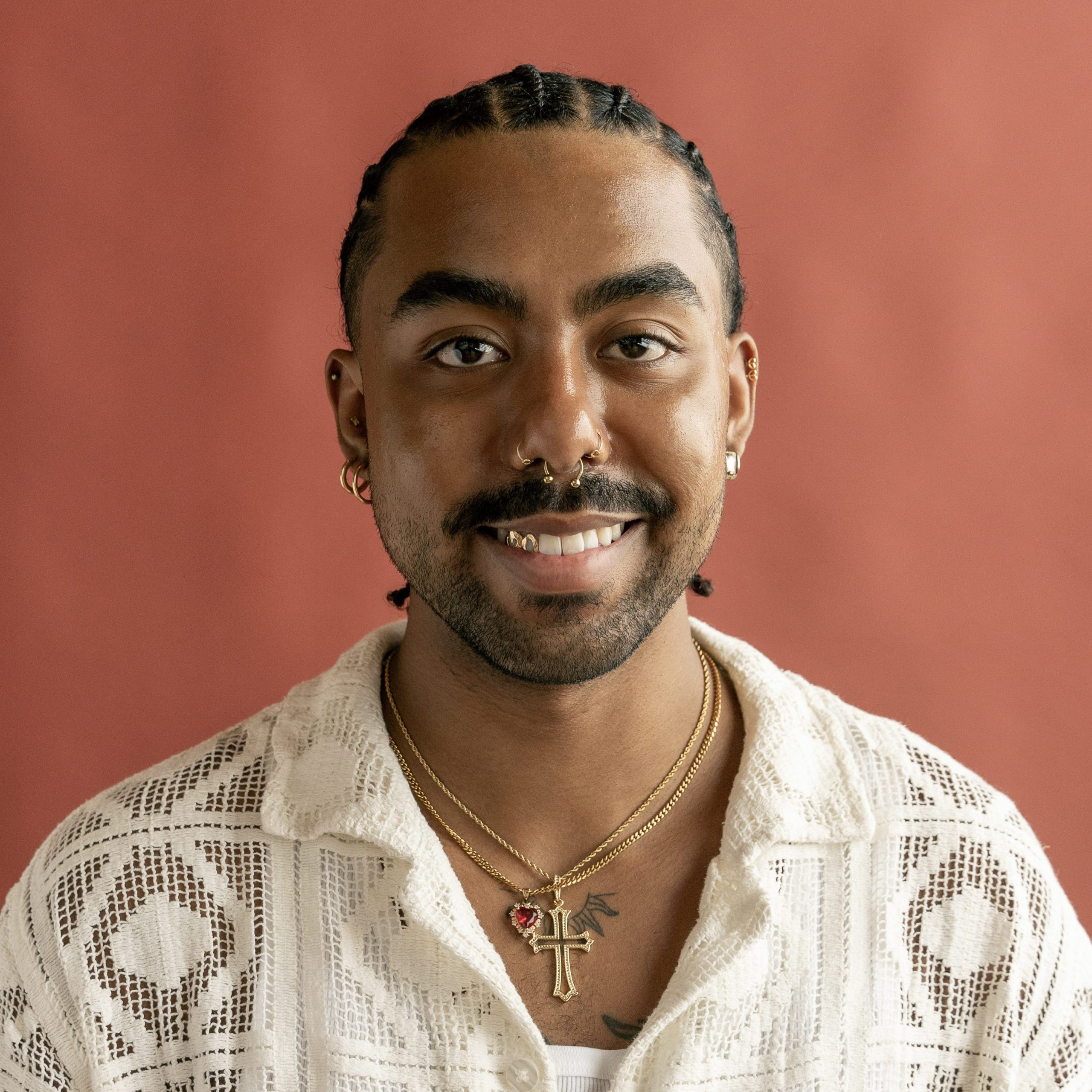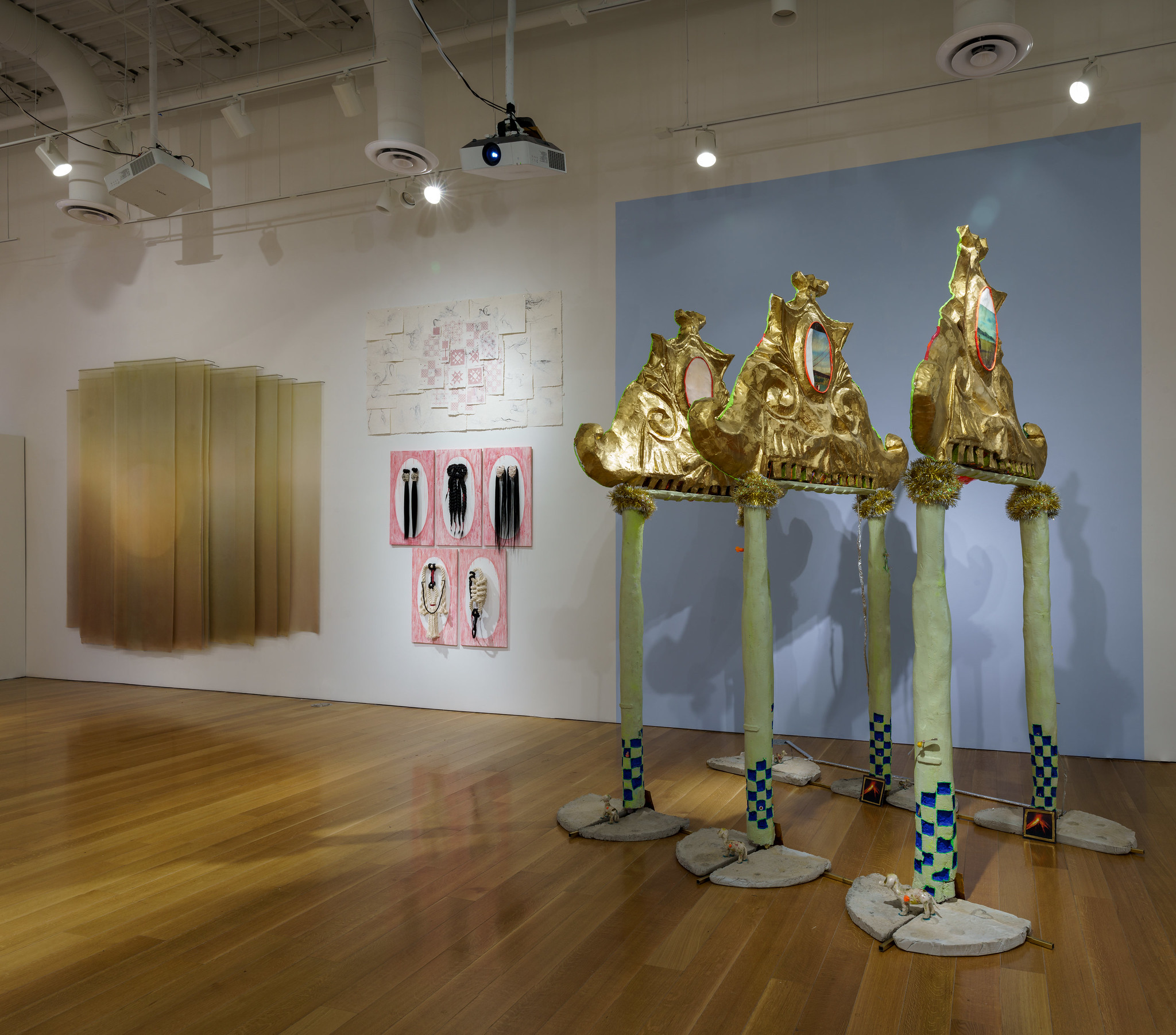Initially, I worked with curator Yashira Davalos as an artist in her first group exhibition part of her Curatorial Fellowship with Charlotte Street in Kansas City, MO, Miss/They Camaraderie 2024. The exhibition drew heavily on local archives to examine desirability, gender-expression and Black aesthetics–while working with lens-based artists back in her previous areas of residence, New Orleans and Atlanta, to shape the exhibit into a more whimsical, satirical pageant show. I’ve learned that Davalos’s vision is complex, fantastical, critical and needed in a time as Kansas City wrestles with hyper post-modern development. Her latest project, Allegories of Inertia, links performance art with the ‘96 Summer Olympics in Atlanta and Kansas City’s impending FIFA 2026. Davalos merges historical and current events through satirization, infusing her experienced ecologies across the “Black Belt” and Midwest, creating a high-level discourse around development, displacement, and societal competition.
Upon entering the exhibition, Noelle Choy’s enormous Big Life Theatre greets me such that I have to look up to it (for reference, I am 6’2). Just as the materials Choy has used to make this piece (of which include concrete, steel, televisions, paper mache, resin, foam), itis also an intricate composition–featuring photographs of erupting volcanoes and sculpted dogs on the floor-level, and family photographs up-high. The mixed-media sculpture’s gold roofs and supporting six pillars feel ceremonial in joining the rest of the works in the exhibition.
Yulie Urano’s sunset/sunrise and the first portion of Hair Portrait #1-7 await me. Urano’s work is striking; the hair and rope techniques are intricate, and draw me to envision the person(s) dreamt in each portrait. Above her hair portraits are sashiko-thread papers surrounded by loose, surrounding hair strands that also feel similar in structural form to her portraits but, of course, portrayed in its own distinct way. The works are stacked vertically on the wall, making the works feel extremely expansive and causing me to take a few steps back to examine both and, as a result, take glimpses at neighboring works in the show. I see that the works in this exhibition are all pretty-large, distinct, and positioned in ways that will constantly cause me to maneuver around. This is also where Davalos’ vision begins to cement itself for me as the pieces compete for my own attention and the space they are housed in.
Next to Urano’s works is Marie Bannerot Mcinery’s 11-foot dyed-silk install For some, an epilogue. Mcinerey’s practice of site-responsive work, literally and figuratively, shines here as the work shifts dependent on where I stand in the show; it is, no doubt, my favorite piece in the show and further develops the use of mobility as metaphor. Alexis Borth’s Entos is the only time in the show I can stand still in viewing any of the works, but this time, the install moves as a shadowy-silhouette dances amidst a blueish-purple background.Its auditory elements combine bird calls with the tapping throughout the eight-minute video. Entos is a Greek word and means something along the lines of “within” or “inside”–this rings true with the piece as the silhouette makes movements seemingly trapped within the screen, as well as mirrored images of itself that split-off during Borth’s first-created visual art/audio installation.
Making a left through the maze, Kandy G Lopez’s 9-foot fiber sculpture Luis and accompanying spray-painted paper Invisible Luis installs take up most of the wall and a significant portion of the floor. The positioning of the works mirror each other, and draw me in as I try to map the portions of the fiber sculpture to its painting; this immersion adds a more personal, human element to the show. Luis’s facial expression and invisible counterpart make evoke a sense of dread and wonder as I consider Davalos’s vision for the show; what are the remnants of ourselves we leave behind in the midst of displacement? Also on the floor is Shawn Bitters’s three-dimensional, sand sculpture Arch. The two figures depicted engaging in sexual intercourse, and Shawn’s use of sand as topographical, extrapolate on the themes I’ve been presented thus far: making me feel this piece’s inclusion investigates survival through mobility as merging to be with one another; while still being its own distinct, ‘competitive’ install.
Urano’s final two pieces of Hair Portrait #1–7 and another Kandy G Lopez piece are at the back of the show. Four of the seven artists have multiple installations, separated from each other; this fragmentation of artist works throughout the space reveal more about Allegories of Inertia’s broken space and time, but are also a testament to the curator’s ability to work extensively with and alongside artists. Kandy G Lopez’s Br00klynBetty and Invisible Br00klynBetty are positioned in the same way her Luis‘s pieces are–however, what interests me about this piece is Davalos’s decision to frame Br00klynBetty on a large garage window in the gallery space. Beyond ‘Betty,’ I can see the surrounding area’s lush amount of trees, construction and portions of Kansas City’s developing metropolitan center. Though not necessarily Davalos’s intention, the world behind Br00klynBetty is actively shifting and shaping itself as her and her invisible counterpart are motionless and frozen-in-time.
Making my way back out of the maze, one of Shawn Bitters’s works, Cowboy is displayed on the floor beneath Davalos’s curatorial statement–equal sexual and interesting as his piece, Arch. Alexis Borth’s Entos once again plays on an adjacent wall, though this time, the video plays at a different starting point. Finally, Caleb Jamal Brown’s 60” x 40” Ashes to the Wind, Head in the Sky, Feet in the Mud is tucked away in the corner. While the rest of the pieces add to this narrative of competition, Brown’s piece feels distinctive from others in the show–especially as it’s positioned where folks would get a fuller view upon exiting rather than entering. The use of mud alongside a collaged-painting of the sky slows and grounds me in the land the other works in the show are actively moving across, questioning, and adhering themselves onto. Brown being born in Atlanta, as Davalos, is a special and emotional homage to Davalos’s hometown–literally yet powerfully that I can only assume that the mud used came from Atlanta.
As I exit, I walk under Big Life Theatre again and see that on this side, are three video installations tucked behind the roofs, each telling three different versions of the same story. The videos begin by expressing ideas along the lines of “you are the myth,” and “imagining something more.” The videos replay at seemingly unplanned, disjointed timings, and are the dizzying, fragmented final messages: we, as individuals, will be in competition for land so as long as we succumb to hyper periods of post-modern development and the, subsequent, destruction of our communities.
Allegories of Inertia was on view at Charlotte Street in Kansas City, MO from September 27 to November 9, 2024.
On November 9th at 3:00 pm, curator Yashira Davalos invited audiences to further engage with the exhibition with “Horizontal Floor Exercise,” a performance from Vaughan W. Harrison in collaboration with the vocal trio EleveN2wenty2.

About the author: Nasir Anthony Montalvo (b.1999) is an award-winning transdisciplinary journalist and memory worker based in Kansas City, MO. Montalvo uses archival praxis, digital media, popular education and the written word to move Black diasporic audiences towards life and a true dream beyond social platitudes. Montalvo is most recently founder of {B/qKC}: an archive of Black queer Kansas City history focused on building power across Black queer generations, repairing institutional harm and exhibiting through public art.
Montalvo holds a 2024-2026 writing residency at Charlotte Street; and has been awarded fellowships with The Opportunity Agenda, Diaspora Solidarities Lab, and the Solutions Journalism Network. Montalvo and their work has been published in The Advocate, NPR, Teen Vogue, Cosmopolitan, HelloGiggles, Sixty Inches From Center and KC Studio.
Montalvo is queer, Afro-Boricane, and from Kissimmee, Florida.



